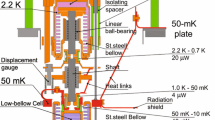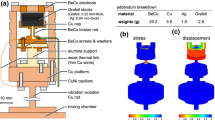Abstract
We have used an acoustic technique to pressurize liquid helium 4 up to 163 ± 20 bar. This is far above the liquid–solid equilibrium pressure Pm, which is 25.3 bar in the low, temperature domain, where the experiment was performed (0.05 K < T < 1 K). This is also far above 65 bar, the prediction of the standard theory for homogeneous nucleation of solid helium. However, no solidification was observed. We discuss our experimental method and the metastability of liquid helium at such very large overpressures. We also propose improvements of our experiment, in order to reach a possible instability limit of liquid helium 4 around 200 bar.
Similar content being viewed by others
REFERENCES
S. Balibar, T. Mizusaki, and Y. Sasaki, J. Low Temp. Phys. 120, 293 (2000).
X. Chavanne, S. Balibar, and F. Caupin, Phys. Rev. Lett. 86, 5506 (2001).
X. Chavanne, S. Balibar, and F. Caupin, J. Low Temp. Phys. 125, 155 (2001).
F. Caupin and S. Balibar, Phys. Rev. B 64, 064507 (2001).
S. Balibar, B. Castaing and C. Laroche, J. Phys. (Paris) Lett. 41, 283 (1980); V.L. Tsymbalenko, J. Low Temp. Phys. 88, 55 (19); J.P. Ruutu, P.J. Hakonen, J.S. Penttila, A. V. Babkin, J. P. Saramaki and E. B. Sonin, Phys. Rev. Lett. 77, 2514 (1996); Y. Sasaki and T. Mizusaki, J. Low Temp. Phys. 110, 491 (1998); T. A. Johnson and C. Elbaum, Phys. Rev. E 62, 975 (2000).
F. Caupin, S. Balibar, and H. J. Maris, Physica B 329-333, 356 (2003).
T. Schneider and C. P. Enz, Phys. Rev. Lett. 27, 1186 (1971).
J. Nissen, E. Bodegom, L. C. Brodie, and J. S. Semura, Phys. Rev. B 40, 6617 (1989).
S. Balibar, X. Chavanne and F. Caupin, Physica B 329-333, 380 (2003).
K. O. Keshishev, A. Ya. Parshin and A. V. Babkin, Zh. Eksp. Teor. Fiz. 80, 716 (1981) [Sov. Phys. JETP 53, 362 (1981)].
J. Bodensohn, K. Nicolai, and P. Leiderer, Z. Phys. B 64, 55 (1986).
S. Balibar, H. Alles and A. Ya. Parshin, submitted to Rev. Modern Phys.(2004).
L. Darrasse, Rev. Sci. Instrum. 53, 1561 (1982).
X. Chavanne, S. Balibar, F. Caupin, C. Appert, and D. d'Humires, J. Low Temp. Phys. 126, 643 (2002).
C. Appert, C. Tenaud, X. Chavanne, S. Balibar, F. Caupin, and D. d'Humi`eres, Eur. Phys. J. B 35, 531 (2003).
In Ref. 4, the inertia of the transducer was neglected so that no phase shift was predicted between the excitation voltage and the transducer response. Here, we find a (p/2)phase shift. We are grateful to H. J. Maris who first mentioned this former mistake to us.
H. J. Maris, Phys. Rev. Lett. 66, 45 (1991).
B. Abraham, Y. Eckstein, J. B. Ketterson, M. Kuchnir, and P. R. Roach, Phys. Rev. A 1, 250 (1970).
D. O. Edwards, M. S. Pettersen, and H. Baddar, in Excitations in 2D and 3D Quantum Fluids, eds. A. F. G. Wyatt and H. J. Lauter (Plenum Press, New York, 1991), p.361.
L. D. Landau and E. M. Lifshitz, Course of Theoretical Physics, Vol. 5, Statistical Physics(Pergamon press, Oxford, 1980), p. 533.
H. J. Maris and F. Caupin, J. Low Temp. Phys. 131, 145 (2003).
P. Leiderer, J. Low Temp. Phys. 87, 247 (1992).
F. Dalfovo, A. Lastri, L. Pricaupenko, S. Stringari, and J. Treiner, Phys. Rev. B 52, 1193 (1995).
H. J. Maris, private communication, unpublished.
K. O. Keshishev, A. Ya. Parshin, and A. V. Babkin, Pis'ma Zh. Eksp. Teor. Fiz 30, 63 (1979) [Sov. Phys. JETP Lett. 30, 56 (1979)]; R. M. Bowley and D. O. Edwards, J. Physique (France) 44, 723 (1983); E. Rolley, C. Guthmann, E. Chevalier, and S. Balibar, J. Low Temp. Phys. 99, 851 (1995).
G. H. Bauer, D. M. Ceperley, and N. Goldenfeld, Phys. Rev. B 61, 9055 (2000).
F. Caupin and S. Balibar, in Liquids Under Negative Pressure, eds., A. R. Imre et al. (Kluwer Academic Publishers, 2002), p. 201.
We have looked for some evidence of the liquid undergoing a superfluid to normal transition at high pressure and low temperature. A change in compressibility at such a transition could show up as some distortion in the shape of the acoustic wave, consequently in the signal from the light scattering by the sound pulse. We have not found convincing evidence that such a distortion occurs at any well defined amplitude of the wave.
H. J. Maris, private communication (2004).
Author information
Authors and Affiliations
Rights and permissions
About this article
Cite this article
Werner, F., Beaume, G., Hobeika, A. et al. Liquid Helium up to 160 bar. Journal of Low Temperature Physics 136, 93–116 (2004). https://doi.org/10.1023/B:JOLT.0000035372.69378.db
Issue Date:
DOI: https://doi.org/10.1023/B:JOLT.0000035372.69378.db




